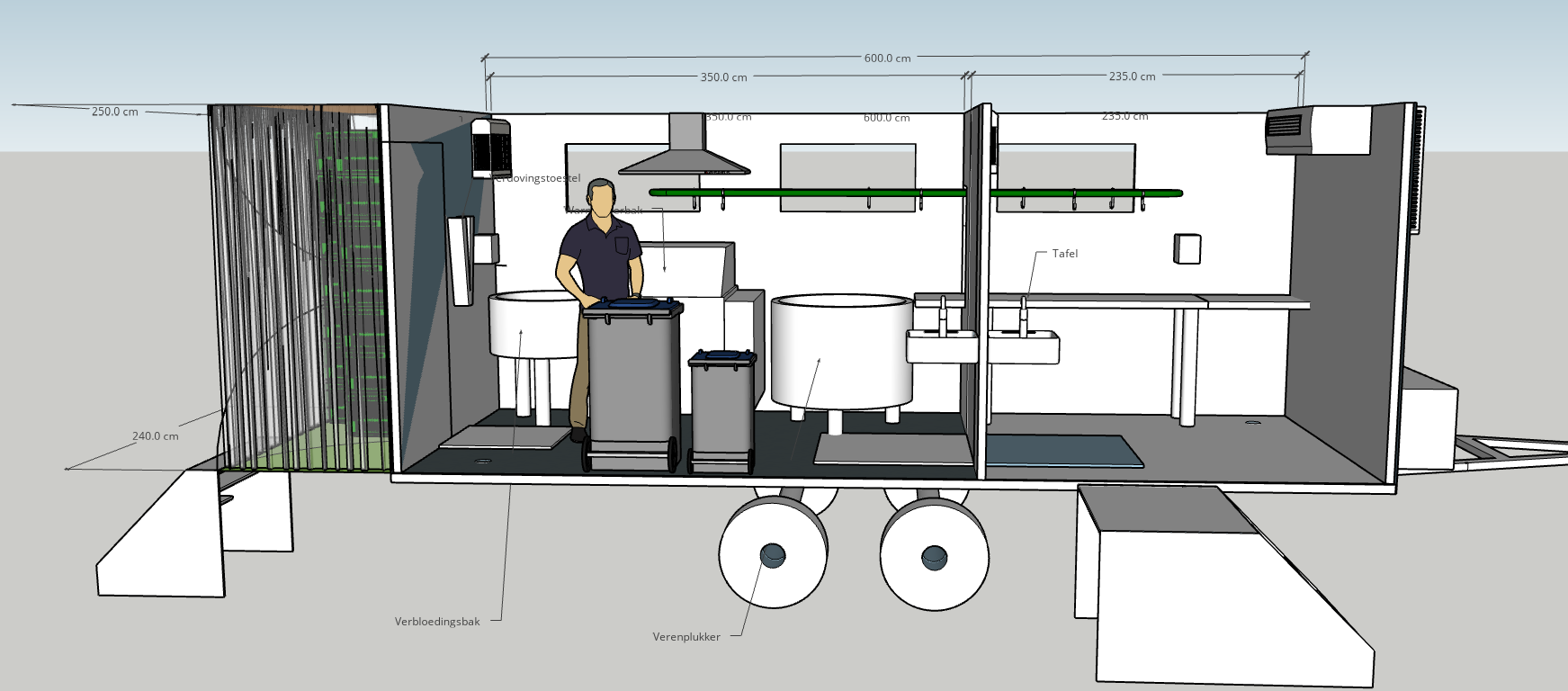Κινητή μονάδα σφαγής για τη βελτίωση της καλής διαβίωσης των ζώων και την ενίσχυση των σύντομων αλυσίδων εφοδιασμού
Ποια ήταν η πρόκληση/ πρόβλημα που αντιμετωπίστηκε?
Η επιχειρησιακή ομάδα «Κινητή Μονάδα Σφαγής’ (MSU) προέκυψε από την παρατήρηση ότι μικρής κλίμακας (οργανικός) Οι κτηνοτρόφοι που έχουν σφάξει για απευθείας πώληση είχαν εδώ και καιρό πρόβλημα να βρουν ένα (βιολογικά πιστοποιημένα) σφαγείο σε προσβάσιμη απόσταση. Τα μικρότερα σφαγεία έχουν κλείσει και τα μεγαλύτερα σφαγεία συχνά δεν είναι εξοπλισμένα για τη σφαγή μικρότερου αριθμού ζώων. Οι μεγάλες αποστάσεις που πρέπει να καλυφθούν με τα ζώα είναι ένα κομβικό σημείο για πολλούς αγρότες και καταναλωτές. Η τελική ποιότητα του κρέατος επηρεάζεται επίσης αρνητικά από το άγχος των ζώων που σχετίζεται με τη μεταφορά.
Η επιχειρησιακή ομάδα αρχικά ανέλυσε τις διαθέσιμες γνώσεις σχετικά με την κινητή σφαγή με βάση μια βιβλιογραφική μελέτη και κατάρτισε έναν κατάλογο ερωτήσεων και σημείων δράσης.
Η εταιρεία «Steunpunt Korte Keten» (“Συμβουλευτικές υπηρεσίες για τη σύντομη αλυσίδα εφοδιασμού τροφίμων”) διεξήγαγε έρευνα μεταξύ κτηνοτρόφων σχετικά με το ενδιαφέρον τους για την κινητή σφαγή, τις προσδοκίες τους, και ανάγκες. Η τυπική απαίτηση είναι η σφαγή 1 ή 2 βοοειδή τη φορά. Για πουλερικά, η συνολική ζήτηση που ερευνήθηκε είναι περίπου 35.000 ζώα ανά έτος.
Το Odisee University College μελέτησε την προστιθέμενη αξία της κινητής σφαγής όσον αφορά την καλή διαβίωση των ζώων. Ο ισχυρισμός ότι η τελική ποιότητα του κρέατος επηρεάζεται αρνητικά από το άγχος των ζώων που σχετίζεται με τη μεταφορά, επιβεβαιώθηκε.
Η σκοπιμότητα όσον αφορά την ασφάλεια των τροφίμων, επεξεργασία απορριμμάτων, και οι περιβαλλοντικές άδειες αξιολογήθηκαν σε συνεργασία με την FAVV, OVAM, και του Τμήματος Περιβάλλοντος. Αν και η νομοθεσία καθιστά δύσκολη την εφαρμογή ενός MSU, δεν το καθιστά αδύνατο.
Τελικά, εκτιμήθηκε η οικονομική σκοπιμότητα. Ένα MSU για τα πουλερικά φαίνεται να είναι βιώσιμο 300 τα ζώα σφάζονται κάθε φορά.
Ωστόσο, για τα βοοειδή, ένα ελάχιστο από 6 ΜΕΤΑ ΜΕΣΗΜΒΡΙΑΣ 7 τα ζώα θα πρέπει να σφάζονται κάθε φορά για να καλυφθούν τα λειτουργικά έξοδα. Στην περίπτωση που σφάζονται λιγότερα ζώα, το κόστος ανά ζώο αυξάνεται γρήγορα σε απαράδεκτα επίπεδα.
Πώς λύσατε το πρόβλημα?
Βρήκαμε λύση για τη σφαγή μικρών ποσοτήτων πουλερικών στο αγρόκτημα. Αυτό δίνει τη δυνατότητα στους μικρούς αγρότες να καλλιεργούν και να εμπορευματοποιούν μικρό αριθμό πουλερικών, ειδικά στελέχη, ή μεθόδους παραγωγής που δεν ταιριάζουν στη βιομηχανική παραγωγή και μεταποίηση πουλερικών. Υπάρχει μικρή αλλά σαφής ζήτηση στην αγορά για αυτόν τον τύπο προϊόντων και σύντομες αλυσίδες εφοδιασμού τροφίμων.
Με βάση τα παραπάνω αποτελέσματα, ένα MSU για πουλερικά μπορεί να φαίνεται το πιο εφικτό, τόσο οικονομικά, τεχνικά, και εντός του κανονιστικού πλαισίου. Ως εκ τούτου, έχει αναπτυχθεί ένα τεχνικό και επιχειρηματικό σχέδιο από έναν επενδυτή και φορέα εκμετάλλευσης για την εφαρμογή ενός MSU για τα πουλερικά 2022 στη Φλάνδρα.
Για τα βοοειδή, η τυπική απαίτηση των αγροτών για σφαγή 1 ή 2 ζώα κάθε φορά είναι πολύ μικρότερη από την ελάχιστα απαιτούμενη ποσότητα 6 ή 7 ζώα για την κάλυψη του κόστους. Αυτό επιβεβαιώνεται από τις εμπειρίες της σουηδικής εταιρείας Hälsingestintan που διαχειριζόταν κινητή μονάδα σφαγής βοοειδών στη Σουηδία. Κι εδώ, Η οικονομική σκοπιμότητα είναι η μεγαλύτερη πρόκληση. Ως πιθανή εναλλακτική, τώρα διερευνούμε την πιθανότητα αναισθητοποίησης και αφαίμαξης βοοειδών στο αγρόκτημα πριν μεταφέρουμε το σφάγιο σε ένα κοντινό σφαγείο για περαιτέρω επεξεργασία. Υπάρχουν πολλά παραδείγματα αυτής της τεχνικής στην Ολλανδία και τη Γερμανία. Το πλεονέκτημα αυτής της τεχνικής είναι ότι το κόστος επένδυσης και λειτουργίας είναι σημαντικά χαμηλότερο από μια πλήρως κινητή μονάδα σφαγής
Ποιοι είναι οι παράγοντες επιτυχίας στην επίλυση του προβλήματος?
Πιθανώς ο πιο σημαντικός παράγοντας επιτυχίας είναι ότι συνεργαστήκαμε με πολλά ιδρύματα, εταιρείες και ανθρώπους, όλοι τους με τη δική τους τεχνογνωσία. Η κοινή γνώση ήταν ζωτικής σημασίας για την εξεύρεση λύσεων για αυτό το περίπλοκο έργο
Απροσδόκητες αποτυχίες, εάν υπάρχει
Η πιο δύσκολη πτυχή είναι η εκπλήρωση των νομικών απαιτήσεων. Μας πήρε πολύ χρόνο για να κατανοήσουμε όλες τις νομικές απαιτήσεις και να βρούμε λύσεις για τη συμμόρφωσή μας με αυτές.
Διδάγματα
Η χρήση γεωπονικών εργαλείων και κριτηρίων για τον προγραμματισμό εφαρμογών λιπασμάτων στις καλλιέργειες θα πρέπει να υπερισχύει της χρήσης των κριτηρίων των μέγιστων δόσεων που επιτρέπονται από τη νομοθεσία 3 κύριες προκλήσεις για τον σχεδιασμό και την υλοποίηση μιας μικρής κλίμακας κινητής μονάδας σφαγής για πουλερικά:
- Τεχνικός
- Οικονομικός
- Νομικός (ασφάλεια των τροφίμων, περιβάλλο, και διαχείριση απορριμμάτων)
Η τεχνική πτυχή φαίνεται να είναι η πιο εύκολη. Από τεχνικής άποψης, είναι απολύτως δυνατή η σφαγή πουλερικών σε κινητή μονάδα.
Ένα οικονομικό μοντέλο δείχνει ότι μια κινητή μονάδα σφαγής είναι ανταγωνιστική και κερδοφόρα μόνο εάν η υποδομή χρησιμοποιείται επαρκώς καθ' όλη τη διάρκεια του έτους και σφάζονται ελάχιστα ζώα ανά εργάσιμη ημέρα.
Η πιο δύσκολη πτυχή είναι η εκπλήρωση των νομικών απαιτήσεων, που επικεντρώνονται κυρίως σε μεγάλης κλίμακας και μη κινητά σφαγεία. Οι περισσότερες νομοθεσίες έχουν υψηλό κόστος, γεγονός που καθιστά μάλλον δύσκολη από οικονομική άποψη παρά τεχνικά τη συμμόρφωση.
Τι ρόλο παίζει ο σύμβουλος ή η συμβουλευτική υπηρεσία στην πρακτική περίπτωση?
BioForum (συντονισμός, ασφάλεια των τροφίμων, και σύστημα ποιότητας, τεχνικές και οικονομικές πτυχές), μαζί με ερευνητές και συμβούλους του Odisee University College (καλή μεταχείριση των ζώων), Κέντρο υποστήριξης βραχείας αλυσίδας (νομικές πτυχές για την ασφάλεια των τροφίμων), Φύση & Πρόοδος Βέλγιο (εμπειρίες στη Βαλλονία) και Κέντρο Υποστήριξης Καινοτομίας (εμπορία) όλοι συμμετείχαν σε αυτό το έργο, συνεισφέροντας και μοιράζοντας τις εξειδικευμένες γνώσεις του καθενός.
Μπορεί η προσέγγισή σας να μεταφερθεί ή/και να προσαρμοστεί για άλλες προκλήσεις και περιοχές καινοτομίας?
Ναί
Εκτιμώμενη δυνατότητα μεταφοράς σε κλίμακα από 1 ΜΕΤΑ ΜΕΣΗΜΒΡΙΑΣ 5
(όπου 1 είναι εύκολο και 5 πολύ δύσκολο)
1
Για την ανταλλαγή εμπειριών σχετικά με την καλή πρακτική, επικοινωνήστε με τον Paul Verbeke (παύλος.verbeke[ΜΕΤΑ ΜΕΣΗΜΒΡΙΑΣ]bioforum.be)
